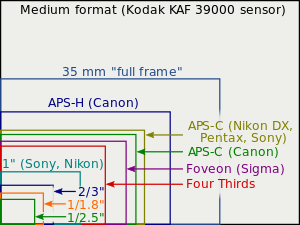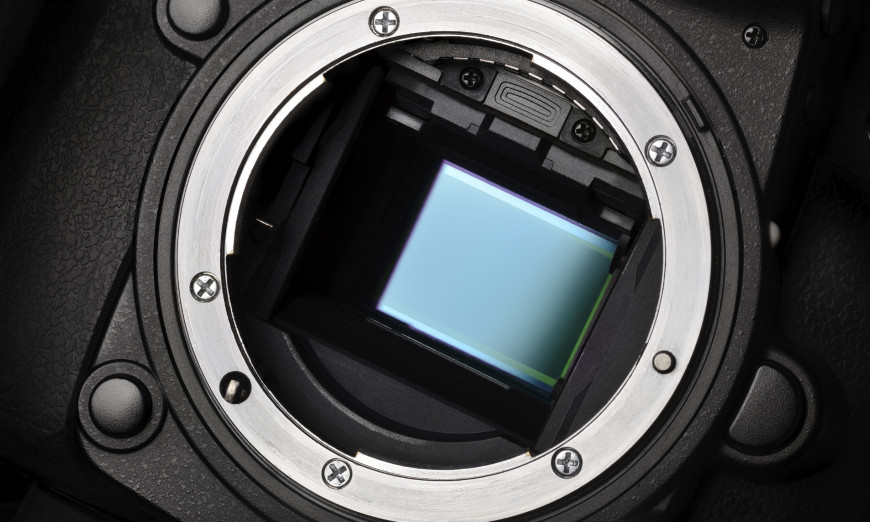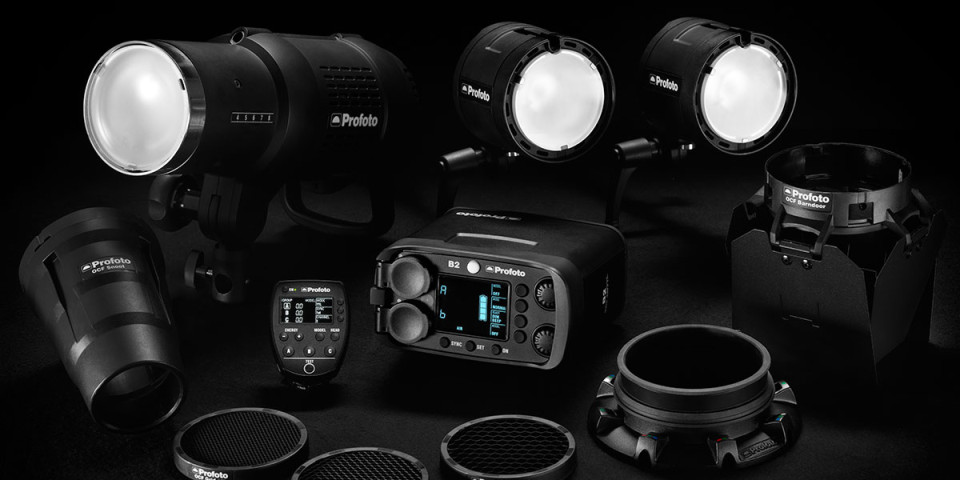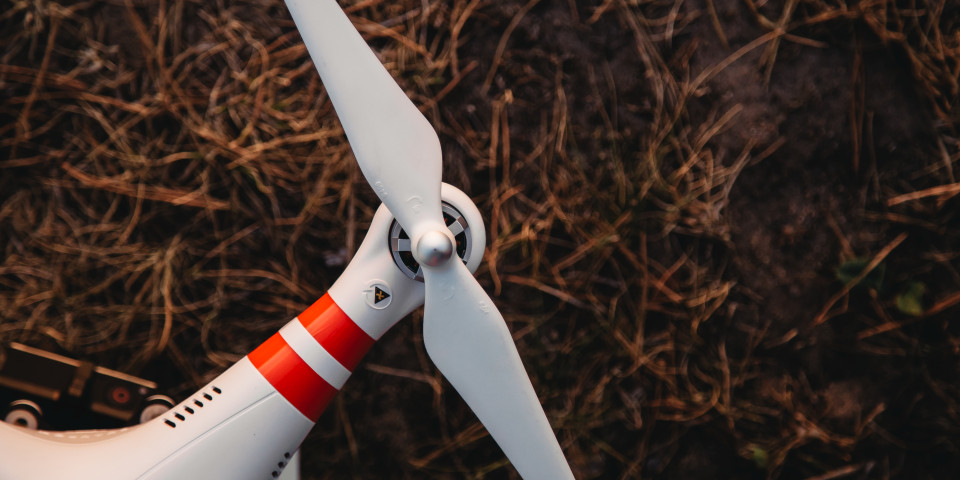After all the years of digital photography, sometimes we assume that everyone understands the term crop factor, or crop sensor and that the concept makes perfect sense to everyone. This past weekend, I was gently reminded that this is not always true, and not understanding can be a real pain to a new photographer, or to a photographer who is becoming more serious about his or her art. Let’s spend a bit of time getting this cleared up.
The Origin of the Term Full Frame

Image Source: Wikipedia
When photographers with long experience hear the term full frame, they think in terms of 35mm film. The phraseology 35mm has lasted since the early days. Cameras built to shoot movies needed a very precise mechanism to advance film through the camera and to have enormous precision on where the film was in the gate when the shutter opened. Spacing had to be perfect. So the movie industry camera makers adopted a film structure from Eastman Kodak that was 35mm across and had sprocket holes down both sides. The actual image size was not 35mm, it was mostly 22mm x 16mm slightly offset on the strip. I’ve included a graphic showing the different sizes for your reference.
As film became enhanced from round sprocket holes to rectangular BH (Bell and Howell) holes to KS (Kodak Standard) holes, it became apparent that a still camera that was oriented longer rather than taller, could still use the same film but would by imaging longitudinally be able to use a larger negative. Thus was born the 36mm x 24mm image size we have come to know as full frame. If you dig through drawers and shoeboxes in your family home, you can probably still find colour negatives and colour slides in this size. Of course there were many other sizes of film used including 120/220, 126, 127, 110 and Disc, the 35mm size became the most popular mostly due to size, image quality and cost.
Going Digital
When the move began to digital sensors from film, it was initially determined that the most obvious route was to use the same frame size so existing lenses could be used on the new cameras. What manufacturers discovered however was that the CMOS sensors of the day were very expensive to build and that the larger the sensor, the higher the probability would be that we would see flaws in the light gathering pixels. Thus was born the idea of the crop sensor. By building the sensor a bit smaller, cost efficiencies would allow for a higher success rate and still maintain the ability to use existing lenses. The original lenses produced an image circle slightly larger in diameter than the diagonal of the 35mm frame, so as a result, these smaller sensors saw less of the overall image circle, they “cropped” in from the edges. The mathematical conversion became known as crop factor, with most cameras today using the very common APS-C crop model. Pretty much all manufacturers offering APS-C sensors have a crop factor of 1.5x (Except Canon who has a crop factor of 1.6x).
A natural consequence of recording a smaller image circle is the illusion thereby created of a level of magnification exemplified by the crop factor. If we use a Nikon or Sony sensor as an example, an image produced by a 50mm lens with a full frame image circle is cropped in by the sensor coverage and so looks, from a magnification perspective as if the image was made with a 75mm lens. There is no actual magnification, we are simply seeing less of the image circle. The decision by manufacturers not to redefine the focal length numbers continues to produce confusion to this day. It is made worse by the fact that many manufacturers use focal length numbers on lenses exclusively for crop sensors that are the same focal length numbers as on lenses for full frame sensors. More confusion reigns. Canon makes two primary lens lineups EF-S, which is crop sensor only, and EF which is full frame but can be mounted on a crop sensor camera. Nikon has DX (crop sensor image circle) and FX (full frame image circle). In Nikon’s case if you mount a DX lens on an FX body, the body switches to crop sensor mode, effectively reducing the resolution to accommodate the smaller image circle. Fujifilm uses an APS-C sensor and measures the focal length of their lenses accordingly. Sony has multiple mounts, with the E mount (APS-C) being best known, but having recently released the FE mount to deliver a full frame image circle on their latest full frame mirrorless cameras.
If you find this all confusing, don’t feel bad. It is confusing. In hindsight the decision to maintain focal length descriptions may not have been the best route given that the sizes of image circle can now vary depending on lens design and specifications.
Sensor Size, Focal Length, Angle of View & Depth of Field
A crop sensor designed lens will be smaller, and potentially less costly than a full frame lens because it is not required to produce as large an image circle. This has resulted in wider range zooms at more customer attractive prices because the lens is not working quite as hard. It does not mean that the lenses are of poorer quality by default, it just means that they only need to produce a smaller image circle.

Image Source: Wikipedia (NOT ACUTAL SIZE)
Some sellers tell clients that when they buy a 200mm lens for their Canon Rebel, they really are getting a 320mm lens. This is not exactly accurate. What they are getting, (Presuming that the 200mm lens is a full frame lens) is a 200mm lens image circle cropped in to resemble the field of view of the 320mm. What is not being delivered is the depth of field characteristics of the 320mm lens, you still get the depth of field characteristics of the 200mm lens. The math tells us that at any given aperture, a smaller sensor has more depth of field than a larger sensor. We know this because our phones have huge depth of field and don’t need a lot of focus work, because the sensor is so tiny.
In our marketplace today we have many sensor sizes to choose from. We can use the tiny sensors in point and shoots and smartphones, or choose something larger. In general, sensor specifications include physical size, and megapixel ratings. A small sensor with a high number of megapixels means that the photo receptors are smaller. A larger sensor with the same or similar megapixel count as a smaller sensor means that the individual photo receptors will be larger. For example, Canon has a DSLR with a 50MP sensor. Hasselblad also makes a 50MP sensor but the sensor is substantially larger and while both sensors deliver 50 megapixels, the larger photoreceptors on the Hasselblad sensor will do a better job in reduced light, and coupling that with a 16 bit image instead of a 14 bit image, will also deliver much higher image quality. You are paying a premium for that, so use cases will drive different photographers to different routes.
Here’s a simple table to help you see how depth of field is influenced by sensor size using f/5.6 as the example aperture with focal length chosen to provide the same angle of view for different sensors.
| Sensor Size | Marked Focal Length | Depth of Field at 10′ | Depth of Field at 3′ |
| Full Frame | 50mm | 4.28′ | 0.37′ |
| Crop Sensor (Sony) | 33mm (50mm FF effective) | 7.01′ | 0.57′ |
| Micro Four-Thirds | 25mm (50mm FF effective) | 9.69′ | 0.74′ |
| Nikon / Sony 1″ Sensor | 18.5mm (50mm FF effective) | 16.55′ | 1.05′ |
| Point and Shoot 1/2.3 | 9mm (50mm FF effective) | Infinite | 2.26′ |
What we learn from the table confirms my prior statement. To achieve a fixed angle of view, different sensors must use different focal lengths to get the same angle of view. In doing so, we find that when the aperture is fixed, the depth of field increases as the sensor gets smaller. Our full frame example has the least amount of depth of field at any distance while our point and shoot has a lot more, and even at a relatively wide aperture of f5/6 basically doesn’t have to focus at all if the subject is ten feet away or farther. This is why focusing takes longer and requires more precision the larger the sensor is.
Some sellers say that if you are a wildlife or sports shooter you are better served with a crop sensor because you get more reach out of your glass. Since the sensor sees less, this appears to be true, but it’s also important to remember that for near equivalent pixel coverage, the sensor pixels are much smaller and so low light performance will not be as good as on full frame, and you will get more digital noise from the smaller sensor components. There is always a tradeoff.
On the other hand, getting to really super wide is tougher on the smaller sensors, not because they cannot cope, but because manufacturers typically don’t build ultra wides designed for crop sensors. So while there are 10mm to something zooms, they have the look of 15mm or 16mm full frame lenses. If you want the real look of an 11mm or even 14mm rectilinear wide angle, you have to go full frame, with a couple of M4/3 exceptions.
Conclusions
Is one sensor size better than another? Should I choose a crop sensor or a full frame sensor? Will I be able to get really shallow depth of field with a mirrorless camera using a micro four-thirds sensor? The answer, as you probably suspect, is “It depends.” What we do know for certain is that the smaller the sensor, the lighter and smaller that the lens can be, and there will be more depth of field at any given aperture and subject distance with the same angle of view chosen. There is no one best answer, so as in all things, it comes down to your needs and your own personal use cases. While there are truly superb smaller sensors on the market, if image quality is your primary driver, you are encouraged to consider the pros and cons of a larger sensor, but remember, while sensor size is a criteria, it’s not the only criteria and there are other things that will impact image quality as well.
Until next time, peace.



COMMENTS (10)
Allison Erhardt
()
Thank you for the great article!
Henry's
()
Hi Allison! We are very glad to hear you enjoyed the article! Thank you for the feedback!
Peter van Rens
()
“The decision by manufacturers not to redefine the focal length numbers continues to produce confusion to this day.”
I don’t believe that the definition of focal length includes sensor size so I’m not sure how that manufactures would work that out.
Henry's
()
Hi Peter,
What the article is referring to in this case, is that the difference in sensor size, will have an effect on the field of view you see in a lens.
Example: a 50mm on a full frame camera is a true 50mm. On an APSC camera (1.5x crop factor) that same lens would then act as a 75mm. Or on a Micro 4/3 camera, (2x crop factor) a 50mm lens give you the equivalent field of view of a 100mm.
The manufacturers have not corrected this, or a standard. they still list the lens at exactly what it is. Therefore, a customer who has experience with full-freak or 35mm equivalent, and decides to look at other platforms, such as a 4/3 system, may see a lens like the Panasonic Leica DG Summilux 25mm f/1.4, and may think this is a wider lens, and purchase it with the intent of using it for landscapes, but in reality, the lens will act like a 50mm on a crop sensor camera body.
Hopefully this brings a bit more clarity!
Peter van Rens
()
Yes I understand the crop factor difference. My point is that focal length is not defined by sensor size and therefore one cannot declare a 50mm lens to be a 75mm lens. It’s a definition, it is not something to be corrected.
“they still list the lens at exactly what it is.” Imagine that.
Adam Janz
()
Thank you for a very well written article!
davidkempton
()
Thanks – great explanation.
David Sanchez
()
Thanks for the review. The dof charts are very revealing. While not directly related, what is a simple explanation of what 100% crop means when people blow up photos on a screen? Thank you.
Henry's
()
Hi David,
What the term 100% crop is referring to, is a translation of the true size of the final image. For example, two full-frame cameras, one with 18 megapixels, and one with 50 megapixels, capture the same image. The camera with 18 megapixels, will provide a native image size of approximately 19 inches wide, and a camera with 50 megapixels will produce a native image of approximately 24 inches wide. When you have the image open in a program such as Photoshop, and you zoom in to 100% view, this is a representation of the detail and quality of the original image, if you were to print it at it’s native size.
Pingback: Introduction To Street Photography | Henry's Blog